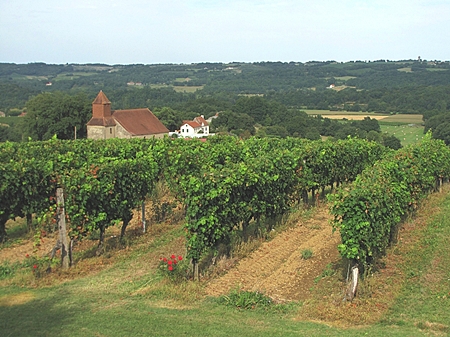I’ve noticed that the wine department in Lotus South has really been improving recently. If you make your way past the huge stacks of gleaming gold and silver whisky boxes you’ll find that there’s a good selection of wines on offer. Best of all, the young ladies on duty leave you to browse in peace. In my case, it’s probably because I give them my “evil eye” as soon as I arrive. After that, they keep their distance. I was recently browsing through the wines in a supermarket in town, when a uniformed young lady approached me clutching a bottle of Concha y Toro Cabernet Sauvignon. “Chilean Red,” she bleated helpfully. I was tempted to say, “Sorry, but I’m looking for a Swedish Green.” But of course, I didn’t.
Château Piarrinne, AC Madiran 2008 (red) France (Lotus South Bt. 449)
Madiran wine comes from the village of the same name in Gascony, down near the Pyrenees. These wines are often quite concentrated, high in tannin and unlike most modern wines actually improve over several years. A good Madiran is rather similar in style to quality Bordeaux.
 Madiran vineyards (© Jean-Marc Puech)
Madiran vineyards (© Jean-Marc Puech)
It’s a very dark red, almost purple wine with a rather oily appearance. I mean that as a compliment, by the way. It makes the wine look more inviting and helps create the little “legs” that sometimes appear inside the glass when you swirl the wine around. And I honestly hope you do swirl it around, for this gets the air into the wine and helps to bring out the aroma which is rich and full, with blackcurrants, cherries and spices. You might pick up some oak and herbs too. After a time (probably about twenty minutes) a faint reminder of mint and chocolate emerged. It was worth waiting for.
The wine has a soft mouth-feel, very supple tannins and 13% alcohol content. It’s full-bodied, with a good balance and a decently long, dry and herby finish. It’s a real “food wine” and would make a good partner for game or assertive cheeses. The Tannat grape makes up most of the blend. This grape is normally found in the South West of France and is noted for its high tannin levels, so it’s usually blended with Cabernet Sauvignon and its vinous cousin Cabernet Franc. Madiran wines are often made by soaking the Tannat grapes with their seeds. Wine made this way is very high in polyphenols, which block the production of a protein that constricts blood vessels, thus reducing the risk of blockages and heart attacks. It has been noted that the people of Madiran have a very long life expectancy.
“Plaisir” Vin de Table (red) France. (Lotus South Bt. 279)
Here’s a real cheapie and if you’re on a tight budget it’s worth a try. It’s a typical knock-it-back wine that wouldn’t be out of place in any French workers’ café. It must be the cheapest vino in town.
It comes from the South, but the bottle gives neither the year nor the name of the grapes, Under French wine law, a wine labelled “Vin de Table”, doesn’t have to, but I’d guess Grenache is in there somewhere. There’s a vague hint of cherries, herbs and black fruit on the aroma and the wine is soft on the palate with a nice little “bite” to the taste. The finish is a bit thin but honestly; it doesn’t really matter because this wine is not for swirling, sniffing and pontificating about. It’s the kind of thing you buy in France in plastic bottles.
For me, this wine brings back warm memories of the South of France in the long balmy days of many summers ago; stopping around lunchtime at a country shop to buy a hunk of local cheese, a freshly-baked baguette and a bottle of simple refreshing wine, just like this one.
Being a European, I tend to drink wine with every meal except breakfast, for even the most basic fare is enhanced by a glass of decent wine. I know my three dogs would agree. They would be extremely miffed if they didn’t get some wine with their pork bones and Pedigree Chum every night. Honestly, I’d never hear the end of it.




